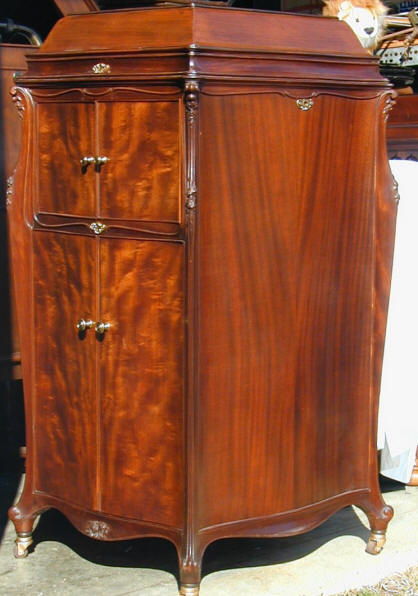The Victor-Victrola Page

Walnut Finishes
Victrolas were produced in two basic types of walnut finishes, but there are many variations within these categories. Walnut can generally be identified from mahogany by a lack of a consistent linear (straight) and parallel grain pattern. This wood often has a characteristic soft or "blurred-swirl" figuring with many varying pattern transitions. Some walnut grains (depending on cut of the veneer) can appear choppy, while walnut veneers on lower-priced models may lack a strong grain contrast altogether. However, some degree of swirl or muted-blending effect is almost always present. Color was always a soft brown. Note that, on the examples shown here, the closely-spaced, strong parallel grain lines that are indicative of mahogany are not evident.
When first introduced, Walnut was only available as a $50.00 option on higher priced machines and very high quality, well-figured veneers were used; some were spectacular in contrast and color.
About Walnut Finishes: Circassian Walnut was the first walnut option to be made available to Victrola buyers in late 1908. This highly-figured, exotic wood was imported from Russia and parts of Northern Italy, as Circassian trees only grew in those regions. It was noted for its bold patterns and strong grain contrasts, and was prized in elegant households of that era. Until recently, it was believed that Circassian Walnut was the only form of Walnut that was available on Victrolas until 1917; however, a few examples of American Walnut Victrolas dating from as early as 1911 have been documented. American Walnut was a more conservative choice in appearance, without the strong (and sometimes "over-the-top") patterning that was found on many Circassian examples. American Walnut, however, was not officially listed as being available on Victrolas until 1917, so it is now assumed that very small "batches" of American Walnut machines were produced as special-order items from 1911 through 1916.
During World War One, the advent of German U-Boat activity began to take a
serious toll on commercial shipping; boats coming across the Atlantic loaded
with products (including Circassian Walnut timber) were sunk at an
alarming rate. This forced Victor to gradually transition from Circassian to
American Walnut for their high-end machines. American Walnut was produced in
the USA, and was readily available, so it quickly became the "standard" walnut
option by the late 'teens. Circassian Walnut finishes were still available
up through 1924, but was being imported in very small quantities.
After 1919, American Walnut
became available as
a no-cost option on some of the less-expensive models, however the veneer quality was much
lower than was used on the high-end flagship machines.
"Crotch" cuts. Walnut veneers which were cut from the junction between two large branches of the tree (crotch) were produced on a very limited basis. These veneers have highly unique figuring and are prized today.
Mix & Match. In the mid-1920's, it was common for Victor to use different types of veneers on the same machine (examples below). Machines with American Walnut/Circassian Walnut and American Walnut/Mahogany, stained to match each other, are occasionally found. This was likely done to use-up batches of veneer at the time when Victor was experiencing serious financial difficulties. These machines can be quite striking and beautiful.
Collectability: In most cases, collectors today prize walnut machines over mahogany or oak (with the exception of the rarest oak finishes). However, Circassian Walnut has always drawn top-dollar from buyers, as it is considered some of the best examples of Victor's woodworking and veneer-fitting skills. The grain can be nothing short of spectacular in some examples. However, there can be a very large overlap between the Circassian and American varities, with many examples sharing traits of both types of wood. We have witnessed many an argument between knowledgeable collectors as to whether a particular walnut machine is of the Circassian or American variety. Since Circassian is virtually always considered to be more valuable than American Walnut, sellers with an "in the middle" machines will usually classify their offering as being Circassian so as to bring top-dollar. There is nothing wrong with this, as there can be broad area of overlap between the two types of wood, but in general, high-end buyers should look for Circassian machines with strong, contrasting figuring so as to be sure that it is a Circassian example. Many high-end American Walnut examples can appear to be Circassian.
Crotch-cut examples of either variety are always considered very collectible.
American Walnut
American Walnut was an expensive option for high-end machines, like this VV-230 (below left). An XVI example is on the right. Note the "soft swirl" patterns and the muted brown shades. The highest quality veneers were used on these models.
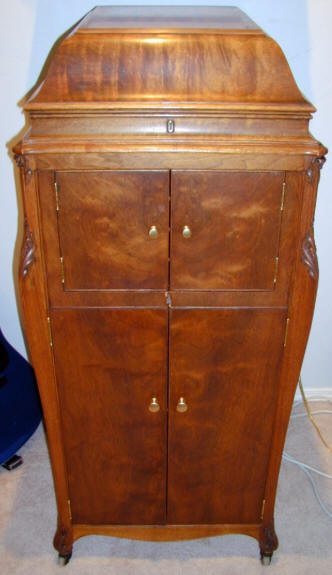
American Walnut became available as a no-cost option on many of the lower-priced models after 1920 (below). Note that the grain-figuring is rather subdued; Victor did not use their best walnut veneers for the less-expensive machines.
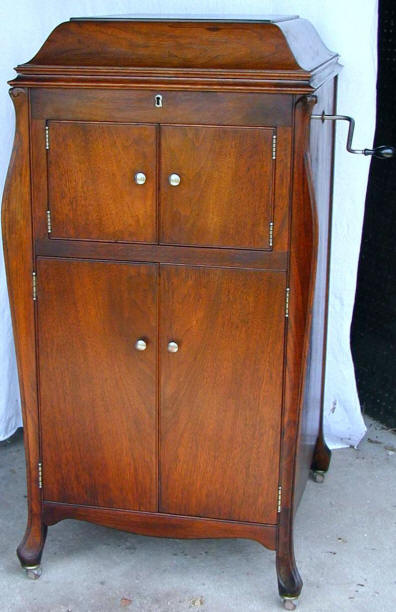
Crotch-Cut Walnut
Wood which was cut at the junction-point between branches can result in a tightly patterned veneer, which is quite beautiful (examples below)
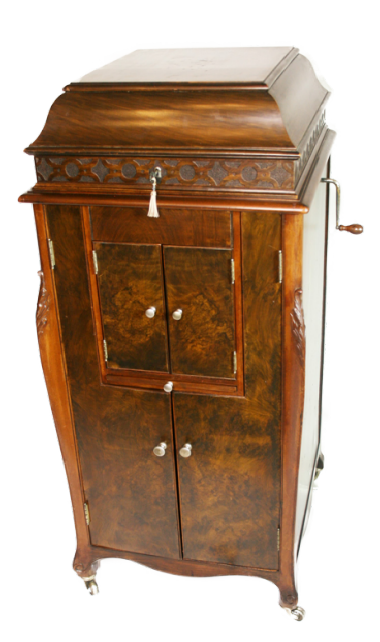
Circassian Walnut
Circassian Walnut has a very distinctive and strong grain contrast, with a most striking appearance. This finish is highly sought after by collectors. Some models with the Circassian veneer that are in excellent original condition have sold for very high prices (depending on rarity of model and degree of figuring). As noted above, American Walnut can easily be mistaken for Circassian Walnut, and some sources will attempt to misrepresent American Walnut machines in order to derive a higher selling price. In some cases, even experts can have difficulty discerning the correct finish, as there are some examples of Circassian Walnut that do not show strong contrasts and appear similar to the American Walnut patterning. This is particularly true for machines made in the early 1920's. However, as a rule for valuation, a machine that has the very strong patterned appearance will almost always bring more money than examples with less grain contrast.

Circassian Walnut Machines can appear very gaudy; these examples will often bring top-dollar
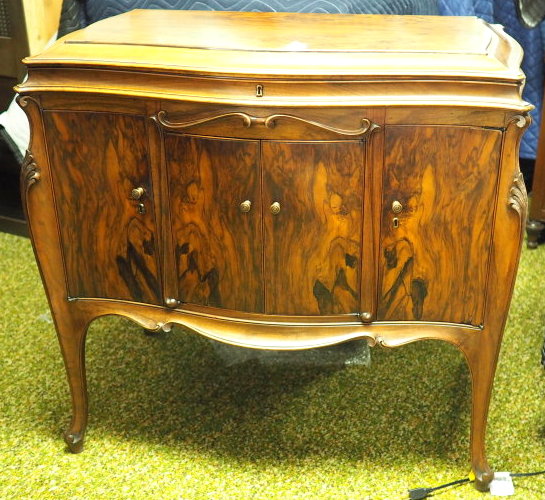
Direct Comparison of a VV-XVIII in Circassian Walnut (left) American Walnut (right) under identical lighting conditions. Note the stronger grain contrast on the Circassian example. However, many variations of veneers and shading are possible.
Combination Veneers ("Mix 'n Match")
Victor commonly mixed veneers in the mid-1920's, particulary on high-end machines. Here we have an example (below) with a walnut front and a probable mahogany side panel. Veneers were stained to match.
